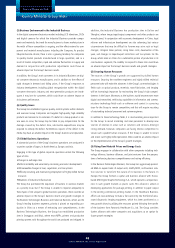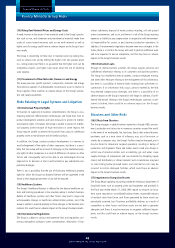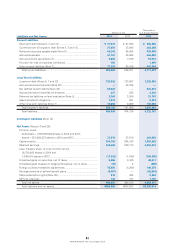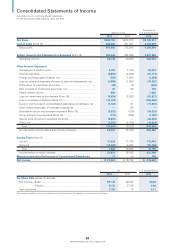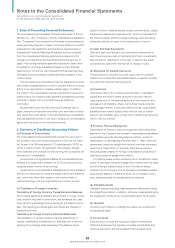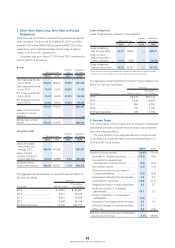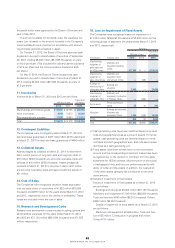Konica Minolta 2014 Annual Report Download - page 58
Download and view the complete annual report
Please find page 58 of the 2014 Konica Minolta annual report below. You can navigate through the pages in the report by either clicking on the pages listed below, or by using the keyword search tool below to find specific information within the annual report.(j) Research and Development Costs
Research and development costs are expensed as incurred.
(k) Financial Instruments
Derivatives
All derivatives are stated at fair value, with changes in fair value
included in net income for the period in which they arise, except
for derivatives that are designated as “hedging instruments”
(see Hedge Accounting below).
Securities
Investments in equity securities issued by unconsolidated sub-
sidiaries and affi liates are accounted for using the equity method
of accounting; however, investments in certain unconsolidated
subsidiaries and affi liates are stated at cost due to the immate-
rial effect of the application of the equity method of accounting.
Held-to-maturity securities are recognized using the amortized
cost method (straight-line method).
Other securities for which market quotes are available are
stated at fair value. Net unrealized gains or losses on these
securities are reported, net of tax, as a separate component of
net assets.
Other securities for which market quotes are unavailable are
stated at cost, except in cases where the fair value of equity
securities issued by unconsolidated subsidiaries and affi liates or
other securities has declined signifi cantly and such decrease in
value is deemed other than temporary. In these instances, secu-
rities are written down to the fair value and the resulting losses
are charged to income during the period.
Hedge Accounting
Gains or losses arising from changes in fair value of derivatives
designated as hedging instruments are deferred as an asset or a
liability and charged or credited to income in the same period
that the gains and losses on the hedged items or transactions
are recognized.
When a currency swap contract meets certain conditions, the
hedge item is measured based on the contractual exchange rate
(designated hedge accounting). When interest rate swap con-
tracts are used as hedges and meet certain hedging criteria, the
net amount to be paid or received under the interest rate swap
contracts is added to or deducted from the interest on the
assets or liabilities for which the interest rate swap contracts
were executed (specifi ed hedge accounting).
Derivatives designated as hedging instruments are primarily
interest rate swaps, currency options, currency swaps and
forward foreign currency exchange contracts. The related
hedged items are trade accounts receivable, trade accounts
payable and long-term bank loans.
The Companies’ policy is to utilize the above hedging instru-
ments in order to reduce exposure to the risks of interest rate
and exchange rate fl uctuations. As such, the Companies’ pur-
chases of the hedging instruments are limited to, at maximum,
the amounts of the hedged items.
The Companies evaluate the effectiveness of their hedging
activities by reference to the accumulated gains or losses on the
hedging instruments and the related hedged items on the date
of commencement of the hedges.
(l) Retirement Benefi t Plans
Accounting Method for Retirement Benefi ts
1. Method of attributing expected retirement benefi t payments
When calculating retirement benefi t obligations, the periodic
allocation method is used to attribute expected retirement
benefi t payments in the period until the end of the fi scal year
ended March 31, 2014.
2. Method of amortizing actuarial differences and prior service
costs
Prior service costs are amortized on a straight-line basis over
certain periods not longer than the expected average remain-
ing years of service of the employees active at the time the
service costs are generated (principally 10 years).
Actuarial differences are amortized on a straight-line basis
over certain periods not longer than the expected average
remaining years of service of the employees active at the
time the amounts are generated (principally 10 years), starting
from the fi scal year following the fi scal year in which the gain
or loss arose.
Accrued Retirement Benefi ts for Directors
Consolidated subsidiaries recognize a reserve for retirement
benefi ts for directors based on the amount payable at the end of
the period in accordance with their internal policies.
(m) Per Share Data
Net income per share of common stock is calculated based on the
weighted-average number of shares outstanding during the year.
Cash dividends per share for each year as disclosed in the
accompanying consolidated fi nancial statements are dividends
declared for the respective year.
(n) Practical Solution on Unifi cation of Accounting Policies
Applied to Foreign Subsidiaries for Consolidated Finan-
cial Statements
Effective from the year ended March 31, 2009, the Company
applied the “Practical Solution on Unifi cation of Accounting
Policies Applied to Foreign Subsidiaries for Consolidated Finan-
cial Statements” (Accounting Standards Board of Japan (ASBJ)
Practical Issues Task Force (PITF) No. 18, issued by the ASBJ on
May 17, 2006).
The Company has made necessary adjustments upon consol-
idation to unify accounting standards for foreign subsidiaries to
be consistent with the Company.
(o) Changes in Accounting Policy
Application of Accounting Standard for Retirement Benefi ts
Effective from the fi scal year ended March 31, 2014, the Group
applied the Accounting Standard for Retirement Benefi ts (ASBJ
Statement No. 26, May 17, 2012 (hereinafter, the ”Statement
No. 26”)) and Guidance on Accounting Standard for Retirement
Benefi ts (ASBJ Guidance No. 25, May 17, 2012 (hereinafter, the
57
KONICA MINOLTA, INC. Annual Report 2014



